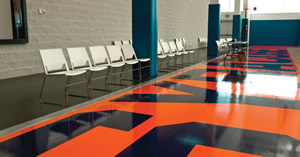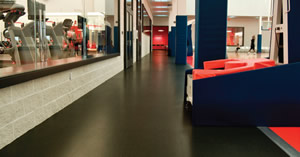Flooring Matters: Finding What Works

PHOTO © EMA PETER
Many factors can affect a higher education institution’s brand or what people should think of that institution, its academic mission, administrative practices, and competitive position. Those things speak to an institution’s goals, its way of life, how it handles change, how it achieves big matters and handles routine tasks. Reputations are also partially forged, or frayed, at literal points of contact, such as building interiors.
Interiors include finishes, including flooring, which is a highly conspicuous element inside any building. Floors represent institutions, directly or indirectly, and have demands that are specific and changing. For example, administration offices, student centers or residences, science laboratories, or lecture halls all have flooring needs that are divergent within a given building and in comparison, to others on campus. Those needs evolve and are often accompanied by challenging budgetary requirements and installation time constraints.
Flooring as Part of the Institutional Brand
Institutions responding well and with vigor to such challenges signals a strong brand, as in, for example, whether the institution is efficient and able to discern and embrace opportunities, both large and small, that come with change.

PHOTOS © NORA
“It is important that the brand be reflected in every building,” argues Tim Cole, vice president of marketing at nora systems, Inc. “The floor covering can help reinforce a brand, either through color choices, designs and patterns, and/or a consistent use of wayfinding,” Cole explains. “It can also support the movement toward open, flexible classrooms, making it easy to flow from one space to another while supplying the performance requirements (e.g., good acoustics) that speak to a positive learning environment and a quality education program—part of any strong brand.”
A campus is well served to stamp its brand, figuratively speaking, on the floors of a crucial building type: student residences. Several years ago, New York’s Syracuse University did so in part by updating flooring in 22 residence halls with a “nora rubber flooring to cover dorm entrance areas, corridors, common spaces, and stairwells,” according to the company, which notes the system was easy to install and maintain—no wax or coatings are needed—and has performed well. The rubber enhances safety, while holding up to trailed-in snow and salt. The flooring system provides these things while looking attractive, an attribute of another nora floor at Syracuse: that of the Carmelo K. Anthony Basketball Center, the company says. Part of that floor “surrounds the court and provides a sophisticated contrast with the signature Syracuse orange color featured at the ends of the basketball court’s floor, producing a clean, high-tech visual attraction,” according to nora.

PHOTOS © NORA
As David Dembowitz, Mohawk Group’s senior vice president of sales, explains, “using certain colors and motifs, flooring can enhance the collegiate student environment by promoting school spirit and pride. Beyond colorways, platforms, dimensions, finishes, and other attributes, flooring is an incredibly customizable surface for higher education spaces. Flooring can also help effectively communicate a school’s identity by setting a specific tone for each and every space on campus.”
There’s yet another point: Dembowitz argues that “because student satisfaction is closely linked to the appearance of their learning spaces, engaging, durable, stylish flooring that is also in line with the school’s branding could potentially be an asset to a larger portfolio that helps with student retention.”
As for durability, he adds that flooring can meet “a variety of needs as those needs continue to evolve in a higher education setting. Well-made, durable floor coverings will withstand the impact of high-traffic corridors, widely used lecture halls, and popular common areas.” Dembowitz adds, “Some flooring options may allow for easier updates and small-scale replacement depending on format and installation method. Ultimately, the right flooring is going to be able to help facilitate a beautiful learning environment that changes with the times.”
Put another way, what’s underfoot can exemplify an institution’s positive brand in spaces with uses that may be in flux.
Power in the Floor

PHOTO © CONNECTRAC
Flooring aside for a moment, as technological needs in campus spaces evolve, so too should efficient solutions to meet those needs. Clint Strong, CEO of Connectrac, points out that his company provides an aesthetically pleasing, flexible solution that can be installed quickly—no core drilling, trenching or floor boxes are needed, the company notes—without leaving exposed cables, which are trip hazards. The approach is about getting students and faculty access to “the power and data they need,” as Strong says. He adds that that floor-based cable management can meet the needs of today’s computer labs as well as spaces in graphic design and engineering departments, among others. Such systems may also be needed in another campus hot spot for change: libraries.
In fact, many campus libraries are undergoing changes along various parameters, such as being transformed into learning commons. For example, officials at San Jacinto College in Texas sought to infuse two campus libraries with the college’s goals of innovation and student success. Flooring was part of that process. Vivid color and graphic elements of a Mohawk Group carpet tile system reflected those goals by contributing to an attractive, sophisticated environment that draws in students. Further, “changes in pattern and color delineate spaces and assist with wayfinding,” the company adds.
Floors that Perform
Performing arts spaces are another example. In those campus areas, the right flooring system “can exemplify and extend an educational institutions identity/brand by demonstrating the university’s commitment to providing their students with top-notch tools to further their education,” says Chrissy Ott, marketing director for Harlequin, which provides sprung and vinyl flooring systems for the performing arts.
Ott explains, “a university known for having exemplary facilities would complement that by having a proper flooring system for dance and performing arts.” She points out that a Harlequin sprung floor system called Liberty panels “can adapt to changing needs, as it is modular—can be used interchangeably in different campus settings—perhaps in a classroom for dance during the day and then on stage in a multi-use auditorium at night for a musical theatre performance. The system is also quick and easy to install—in the day and age of the ‘microwave’ generation and wanting everything available instantaneously, the system has that flexibility.”
Various factors were at play when floors were specified for the University of Southern California’s Glorya Kaufman International Dance Center, which opened in 2016. During the center’s construction process, Harlequin supplied a floating, or unaffixed, sprung floor system that quickly enabled classrooms to serve as temporary dance studios as well as a permanent system for the new building itself, according to Harlequin.
How an institution responds to the rigors of perpetual, frequently swift change is just one of the many things that can affect an institution’s reputation. Building interiors are another such thing, and flooring is a highly conspicuous part of those interiors each and every day. That much stays the same.
This article originally appeared in the College Planning & Management February 2018 issue of Spaces4Learning.